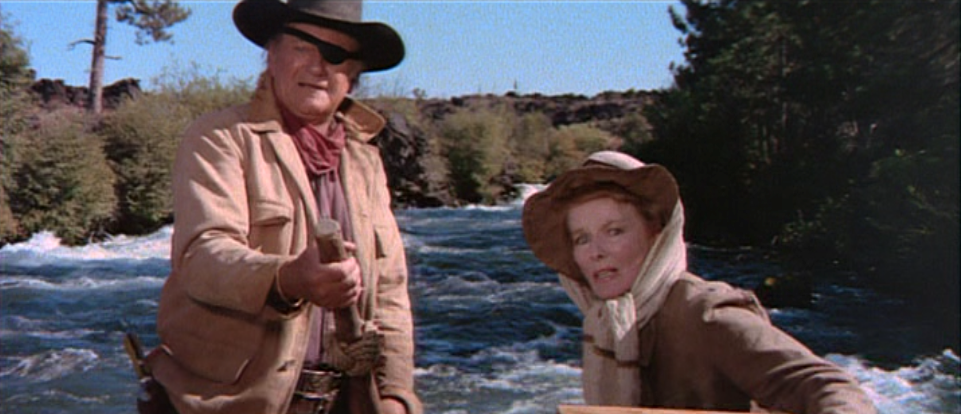Episode 42 of 52: In which Katharine Hepburn and John Wayne star in The African Queen 2: This Time it's a Western!
 Growing old in Hollywood sucks. To borrow a line from Goldie Hawn, “There are only three ages for women in Hollywood: babe, district attorney, and Driving Miss Daisy.” And while Hollywood’s ageism is well-documented and well-criticized, for some aging actors, an equally tricky problem can arise: the trouble with becoming a Legend in your own time. What happens when the legend eclipses the actor?
Growing old in Hollywood sucks. To borrow a line from Goldie Hawn, “There are only three ages for women in Hollywood: babe, district attorney, and Driving Miss Daisy.” And while Hollywood’s ageism is well-documented and well-criticized, for some aging actors, an equally tricky problem can arise: the trouble with becoming a Legend in your own time. What happens when the legend eclipses the actor?
In 1975, Hepburn was arguably more popular than she’d ever been. This was due in no small part to her friend Garson Kanin’s unauthorized, best-selling 1972 “tell all” entitled Tracy And Hepburn: An Intimate Memoir. Though shocked by the invasion of her privacy, Kate used the public interest that the book generated to fuel her career, appearing on talk shows and even the 1974 Academy Awards (in pants, of course). As a result, in the 1970s, while Bette Davis was taking guest roles, Joan Crawford had retired, and Barbara Stanwyck "slummed" it in TV, Katharine Hepburn was as prolific as she’d ever been, starring in seven movies total. However, her popularity came at cost. Kate became in effect the curator of her own legacy, more valuable as a symbol of the past than as a well-respected thespian in the present.
Certainly, it was Katharine Hepburn the Legend that director Stuart Millar and producer Hal B. Wallis had in mind when they paired her with John Wayne in Rooster Cogburn. Five years after Wayne won his Academy Award for True Grit, Wallis’s wife Martha Hyer penned a sequel designed to play to its two stars’ greatest strengths: take the American Odyssey outline for True Grit, fill it with details from The African Queen (including more white water rapids), add a few pounds of nitroglycerin and some extra genre cliches about the death of the American West, and voila! Rooster Cogburn is born.
Westerns, Oscars, and a comparison Meryl Streep after the jump.
 I have the strangest sense of deja vu.
I have the strangest sense of deja vu.
The problem is that the movie invites comparisons to earlier Hepburn and Wayne vehicles, but doesn’t have the heft of the films it seeks to emulate. (Although it did prove to me how similar the set ups of True Grit and The African Queen are.) It’s a weak John Wayne movie without the questionable heroics and mournful American spirit that the Duke represented. Likewise, it’s a weak Katharine Hepburn movie that resurrects the tough spinster image, but doesn’t do anything with it. Kate does get two interesting scenes: one reciting Psalms while a badguy fires at her feet, and another where she shoots a man in the back. (Side note: it’s the first time Kate’s killed a man onscreen.)
Nonetheless, Hepburn and Wayne are good. Effortlessly good. Neither is trying very hard, and both are having a wonderful time not doing so. In yet another I-didn’t-think-this-would-work-but-somehow-it-does bit of actorly alchemy, Kate and the Duke have great opposites-attract chemistry as Rose Sayer Eula Goodnight and Rooster Cogburn. Hepburn and Wayne skate through the film on their own charisma and star power. Not bad for two old codgers.
In 1975, Katharine Hepburn was 68 years young, the same age as Glenn Close is now, and only a few years older than Meryl Streep. Usually I avoid comparisons between La Streep and Kate the Great (though I know one is on the horizon), but I think it’s important to note the difference that 40 years make. Though Close may not work as much as we wish she would, in 2014 both she and Streep are still prominent, relevant actresses. In 1975, Katharine Hepburn was being hailed (read: burdened) as a monument from a lost era. This is a moniker that Close and La Streep have so far avoided, with good reason: monuments are by definition immobile.
Finally, since I know you want to see it: here's the clip of Kate at the 1974 Academy Awards, presenting the Irving Thalberg Award to her friend Lawrence Weingarten.
Would you wear slacks to the Oscars? How do you see our current Great Actors and Actresses handling ageism and the burden of being living legends?

 Previous Week: Love Among The Ruins (1975) - In which Katharine Hepburn does a TV movie with Laurence Olivier and George Cukor, which might have been disappointing if it wasn't so good.
Previous Week: Love Among The Ruins (1975) - In which Katharine Hepburn does a TV movie with Laurence Olivier and George Cukor, which might have been disappointing if it wasn't so good.
Next Week: Olly Olly Oxen Free (1978) - In which Katharine Hepburn proves she's not afraid of heights or bad scripts.